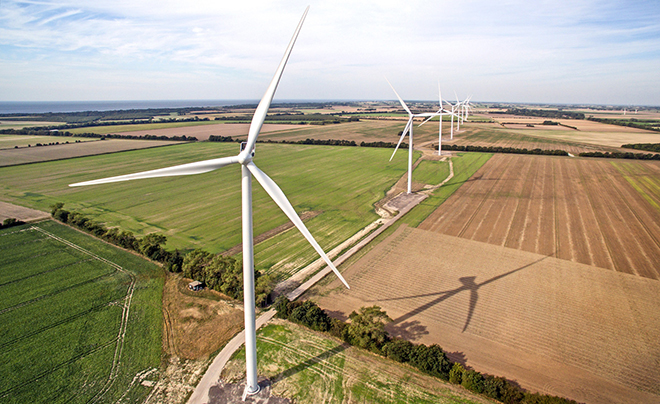
Wind turbines in Denmark. The EU is proposing to cap revenues from certain power generators to ease the pressure on consumer energy bills. |
A proposed cap on European renewable energy revenues could be difficult to implement and create uncertainty if member states adopt it in an uncoordinated fashion, according to analysts and industry groups.
The European Commission outlined a series of proposed measures Sept. 14 to combat spiraling energy prices in the bloc since Russia's invasion of Ukraine, including a temporary cap of €180/MWh on revenue from inframarginal generators, or generators believed to be producing power well below market rates. That now includes renewables, nuclear and lignite assets that make money from selling power on the wholesale market.
Such generators have enjoyed unexpected windfalls as a result of the surging price of gas, which as the most expensive technology sets the price of electricity in the EU. Year-ahead power contracts in Germany were at €517/MWh on Sept. 14, exchange data showed — about 10 times higher than typical levels.
The intervention by the EU is intended to channel funds back to consumers to help them with rapidly increasing energy bills. However, industry groups criticized its design — in particular, the fact that the commission would allow member states to deviate from the regulation and introduce stronger revenue clawback measures. WindEurope, a trade group, said this would result in a "patchwork of different price caps" and lead to investment uncertainty.
The commission called on member states to adopt only regulations that are "proportionate, do not distort the functioning of electricity wholesale markets, do not jeopardize investment signals and ... are in line with [EU law]."
'Extraordinary' profits from war
The proposed revenue cap is part of a raft of market interventions by the EU to bring down energy costs for consumers. The commission said the cap would raise up to €117 billion on an annual basis, and wants member states to enact the proposal from no later than Dec. 1, 2022, until at least March 31, 2023. EU energy ministers are scheduled to meet Sept. 30 to decide whether to approve the cap.
"In our social market economy, profits are OK, they are good. But in these times, it is wrong to receive extraordinary record profits benefiting from war and on the back of consumers," European Commission President Ursula von der Leyen said in her State of the Union address Sept. 14 in Strasbourg, France.
The scope of the measure in member states will vary depending on the level of wholesale market exposure of their generation fleets.
The proposal will cover renewables projects that are contracted under power purchase agreements, or PPAs, but not those that benefit from government support programs, according to WindEurope. Companies that forward-hedge their power sales will also be subject to the cap. However, neither hedging nor PPAs are likely to be affected since such prices are typically below the level of the cap already, WindEurope added.
Meanwhile, all of Europe's lignite and nuclear capacity will be covered, except for certain volumes of French nuclear sold by Electricité de France SA at fixed prices, according to Coralie Laurencin, senior director at S&P Global Commodity Insights.
"All of the capacity in Germany [and] most of the renewable capacity in Scandinavia would fall under this regulation, and for most other markets it's going to be somewhere in the middle between none and all," Laurencin said in a Sept. 15 webinar.
Implementation could be problematic, however, given generators are only required to disclose the price, quantity and time frame of their power when they sell into the wholesale market, and not the name or technology of their asset, according to Laurencin.
"It really depends on self-disclosure," Laurencin said. "The information needed to make this happen right now is not publicly available."

Upside for renewables
Reaction to the commission's proposal from the renewables industry has been generally mixed.
Swedish state-owned utility Vattenfall AB, which operates wind farms in multiple European nations, said it "risks hindering investments into new fossil-free electricity production," adding that the temporary nature of the measure is important.
Meanwhile, Louis-Mathieu Perrin, CFO at French renewables group Neoen SA, said the mechanism will "bring clarity on what renewable power producers can expect going forward."
Like many players, Neoen derives most of its revenue from PPAs with public counterparties, utilities or corporate buyers, but it is also partially exposed to wholesale electricity prices in Finland, France and Ireland. In the first half of 2022, 13% of its wind and solar revenues came from the spot market.
Renewables developers typically have "lower merchant price assumptions embedded in their financial models" than €180/MWh, Perrin said in an email. "This cap would as such represent an upside compared to the initial business plans and in any case, help absorb recent increases in input costs and notably [capital expenditure] and financing costs."
In detailing their revenue cap proposal, commission officials pointed out that €180/MWh is a good deal for inframarginal generators. EU simulations based on observed prices from January to August showed that a €180/MWh cap would have resulted in average revenues of around €150/MWh — "consistently higher" than the cost of producing energy from renewables or nuclear, officials said.
Analysts at Morgan Stanley said Sept. 14 that the level will continue to incentivize renewables investments and price-driven demand destruction, and "encourage asset owners to sell renewables volumes forward on multiyear contracts now that upside benefit from merchant exposure is capped." Jefferies analysts pointed Sept. 13 to potential upsides for power producers such as RWE AG, Drax Group PLC and SSE PLC.
"The EU is very clear that they have set the price at a level such that no one feels like they're being ripped off," Laurencin said.
S&P Global Commodity Insights produces content for distribution on S&P Capital IQ Pro.



